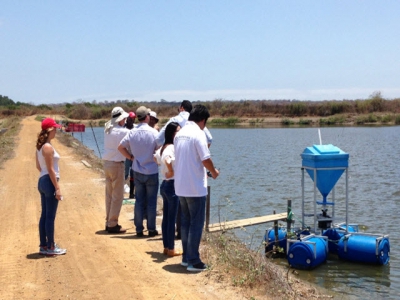Skretting using Ecuador ‘validation station’ to show new shrimp feeding methods
About two hours from Ecuador's largest city down a series of dirt roads that straddle hectares after hectares of shrimp ponds is a building that seems
 Lobster shell disease moving towards Maine
Lobster shell disease moving towards Maine A shell disease that has run rampant through the US New England’s lobster industry for years has moved northward to the lobster-filled grounds off the Maine coa
 New ‘killer’ shrimp virus threat in China as production drops
New ‘killer’ shrimp virus threat in China as production drops The issues with acute hepatopancreatic necrosis disease (AHPND) -- more commonly known as early mortality syndrome, or EMS -- and other diseases
 Do current shrimp practices favor EMS?
Do current shrimp practices favor EMS? Early mortality syndrome (EMS), also known as acute hepatopancreatic necrosis, typically affects shrimp postlarvae within 20 to 30 days after stocking
 Regional authorities in China move to close 40,000 shrimp ponds
Regional authorities in China move to close 40,000 shrimp ponds Authorities in Jiangsu Province’s recently issued a notice to “quit shrimp or close down” to the owners of up to 40,000 polytunnel-style covered shrimp ponds.
 Ecuador's Sustainable Shrimp Partnership moves forward with creating shrimp-farming standar
Ecuador's Sustainable Shrimp Partnership moves forward with creating shrimp-farming standar The Sustainable Shrimp Partnership, an Ecuador-based certification system for shrimp aquaculture launched in March 2018, is pushing forward with developing
 What to do about EMS/AHPN?
What to do about EMS/AHPN? A number of commonalities have been observed among occurrences of early mortality syndrome (EMS) or acute hepatopancreatic necrosis (AHPN) in shrimp
 A review of unit processes in RAS systems
A review of unit processes in RAS systems This column reviewed important unit processes in recirculating aquaculture system design and began to discuss components used to remove waste solids
 EMS impacts: Disease shifts shrimp supplies, prices, future production
EMS impacts: Disease shifts shrimp supplies, prices, future production Unaffected areas – Ecuador, Indonesia, India, Bangladesh and Myanmar – are rapidly expanding production
 Study challenges farmed shrimp concerns
Study challenges farmed shrimp concerns Scientists at the University of Stirling have challenged concerns around the consumption of imported farmed shrimp - with new research indicating
 Bacterial amendments in shrimp grow-out ponds
Bacterial amendments in shrimp grow-out ponds Technology already providing significant benefits; much potential to improve pond yields
 A new candidate for commercial aquaculture?
A new candidate for commercial aquaculture? A project seeking to close the breeding cycle of the European spiny lobster is showing promising results and may help both to support coastal diversification
 Intensive production of Pacific white shrimp in a photo-heterotrophic, hypersaline system 2
Intensive production of Pacific white shrimp in a photo-heterotrophic, hypersaline system 2 Intensive production of Pacific white shrimp in a photo-heterotrophic, hypersaline system: Part 2
 Intensive production of Pacific white shrimp in a photo-heterotrophic, hypersaline system 1
Intensive production of Pacific white shrimp in a photo-heterotrophic, hypersaline system 1 Intensive production of Pacific white shrimp in a photo-heterotrophic, hypersaline system: Part 1.
 Caveat emptor when seeking for EMS solutions
Caveat emptor when seeking for EMS solutions AHPN is caused by a common bacterium, but wholesale disinfection of aquatic ecosystems is not a sustainable practice.
 Raceway systems offer tools for EMS management
Raceway systems offer tools for EMS management Shrimp raised in round tanks or concrete raceways after transfer from hatcheries gain weight and health before being stocked in ponds for final growout.
 Evaluating a commercial functional diet in AHPND-infected juvenile Pacific white shrimp
Evaluating a commercial functional diet in AHPND-infected juvenile Pacific white shrimp Bacterial and fungal diseases caused by pathogens such as white spot disease virus (WSSV), Taura syndrome virus (TSV), Vibrio parahaemolyticus and Vibrio harvey
 Will disinfectant interfere with probiotics in my shrimp pond?
Will disinfectant interfere with probiotics in my shrimp pond? Many fish and shrimp farmers who are interested in using Halamid, for protection of their valuable crop, ask how this will interfere with the probiotics
 Grain distillers dried yeast in practical diets for juvenile Pacific white shrimp, part 2
Grain distillers dried yeast in practical diets for juvenile Pacific white shrimp, part 2 Inclusion of 150 grams per kilo result in excellent production performance
 Rising use of automatic feeders in shrimp ponds poses new feed requirements (Part 2)
Rising use of automatic feeders in shrimp ponds poses new feed requirements (Part 2) Although the cost of formulated aquafeeds in shrimp farming represents approximately 60 percent of the operating costs, the actual application and distribution
